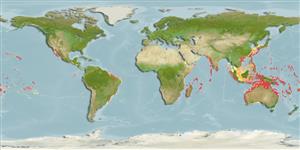Common names from other countries
Environment: milieu / climate zone / depth range / distribution range
Écologie
; profondeur 0 - 82 m (Ref. 89006). Tropical
Atlantic, Indian, and Pacific Ocean.
Length at first maturity / Taille / Poids / Âge
Maturity: Lm ? range ? - ? cm
Dead specimens washed up on beaches, and to 30 m (Ref. 377). Occurs on soft sediments, coral rubble, sand, rocky shores, and tidal pools at intertidal depths. Also on slabs of coral limestone and scattered reefs (Ref. 87907). Living at depths intertidally to 24 m (Ref. 89006). Single valves found on the beaches (Ref. 88739).
Life cycle and mating behavior
Maturité | Reproduction | Frai | Œufs | Fécondité | Larves
Members of the class Bivalvia are mostly gonochoric, some are protandric hermaphrodites. Life cycle: Embryos develop into free-swimming trocophore larvae, succeeded by the bivalve veliger, resembling a miniature clam.
Werner, T.B. and G.R. Allen. 2000. (Ref. 8295)
Statut dans la liste rouge de l'IUCN (Ref. 130435)
statut CITES (Ref. 108899)
Not Evaluated
Not Evaluated
Menace pour l'homme
Harmless
Utilisations par l'homme
| FishSource |
Outils
Plus d'informations
Taille/Âge
Croissance
Longueur-poids
Longueur-longueur
Morphologie
Larves
Abondance
Sources Internet
Estimates based on models
Preferred temperature
(Ref.
115969): 17.6 - 28.8, mean 27 (based on 1406 cells).
